The Frog Banjo Project-2012
Here is a little video clip of the Frog Banjo #1. It was recorded through the L.R.Baggs pickup.
This page is dedicated to one of my my latest endeavors, The Frog Banjo.This is a light-weight banjo which is designed to be more comfortable to hold and play than the traditional ones. It features a 9.5 inch biscuit-type cone, a polished aluminum top, a thin, lathe turned maple body with rounded edges, a standard 5 string banjo scale, and weighs about 4.5 pounds. This banjo incorporates a lot of things that I have learned in the last 35 years of building and repairing stringed instruments. This design is still changing, evolving, and improving. At this time, I have built 3 of these banjos. This project is not a commercial venture. It is my latest efforts to make an alternative sound for the banjo. I met Allen Shelton years ago when he was playing with Jim and Jesse’s Band. He was playing a little 5-string Dobro and he got such a pretty sound from it that it got my attention. In the last 30 or so years, I have since built around 15 or 20 instruments that are alternative 5 strings. I’ve also cut the neck down on some guitars and converted them to 5 strings. I built 2 “Walloons” which featured a Dobro-type pot with the spider. I’ve built several wooden topped banjos which I called the “3 Holer”. This latest design is my first attempt with the biscuit-cone. I realize that there have been quite a few similar instruments built through the years. I know Sonny Osborne played a guitar that had been converted to a 5 string years ago. I’ve seen the Dojo’s, the ResNicks, and some banjos built from everything from bed pans to car wheels. I’ve spent so much time through the years searching for an alternative, that I felt like I wanted to share what I’ve learned. I value the opinions of good musicians.
Here is a picture of my first Frog Banjo. I have a Frog Guitar and I decided to name this banjo project the Frog Banjo. This first effort was enough to get me excited about the concept again. This one has an L.R.Baggs pickup installed in it. The top is polished aluminum and it has a biscuit-type cone that is 9.5 inches in diameter. The wooden arm rest is my design and it makes it feel more comfortable. This was inspired by my old friend, Rual Yarbrough. He gave me an arm rest for my banjo a few years back and it had this smooth angle on it. I incorporated this comfortable angle into my design. I decided to use ball end strings on these instruments. This one has some little screws that will allow you to use loop-end strings if you desire.
This body is around the same diameter as a Gibson-style banjo resonator. The banjos shown here are all prototypes and they were not an effort to be fancy looking. You will see extra holes in some places where something was moved around.
I purchased some parts from Larry Mathis a while back. There were some Gibson resonator backs in the pile. I used these mahogany backs on these Frog Banjos. The sides of the body are maple and were turned on a lathe. These banjos feature my distinctive ultra-rounded edges which are easy on your arm.
Here is the peg head. The truss rod cover on this one is aluminum with a snake doctor decal. The D-tuners are my design. They are Delrin and they operate pretty well. I never could get the Scruggs type to come back into place as well as I wanted. I’ve made several sets of tuners through the years. These are just an experiment. This is a mahogany neck that came from the Stype Brothers in Florida.
Above is a picture of the second Frog Banjo. This body is slightly larger in diameter than the first one. It is ultra thin and seems really comfortable to hold. I painted the center of the top to look like a banjo head. The sides on this body are rounded enough so I didn’t need to add an arm rest. This pot seems to have a little more volume and “punch” than the first one. The 3 that I’ve built all have a little different tone. I suspect that the number of holes in the top and the location of these holes are a factor.
This is a mahogany neck that I purchased from one of my suppliers. It is nothing fancy. I use guitar tuners on these banjos. A banjo tuner is 4 to 1 ratio and a guitar tuner is 12 to 1. I even converted my regular banjo to guitar tuners a while back. I know you traditionalists will say it looks cheap, but I think I spend less time tuning than I used to.
Although this picture looks like the top is dish-shaped, it is basically flat. These banjos will not fit in a traditional banjo case because of the location of the bridge. The extra length that this creates makes it necessary to use a guitar case. The guitar cases are easily converted for this instrument.
Here is the back of the Frog Banjo #2.
Frog Banjos #2 & #3.
Frog Banjo #3. Note the bridge pins have been eliminated. This top started life with a smaller cone and the bridge in the traditional banjo spot.
Frog Banjo #3 peg head.
This is a work -in -progress. These 3 instruments all have a slightly different tone. I’m sure that there will be more changes in the future if I continue to experiment.
Update: Frog Banjo #4 is now completed. We changed a few things and made some improvements that seemed appropriate. We were able to solve the problem of moving the bridge toward the rear of the pot so it feels more like a traditional banjo setup.
We designed a new tailpiece to hold the ball end strings. This pot is slightly smaller in diameter than the others.
We made the holes in the pot closer to the edge and with a more traditional layout. We attempted to make the head size more in proportion to what we felt looks appropriate. One benefit of these changes is that this Frog Banjo will fit in a normal banjo case.
These 4 Frog Banjos have allowed us to learn a lot and we still are experimenting with the design. We made this entire pot from maple instead of using the Gibson Resonator back on this one. I know the grain orientation on the back is not traditional. This is not a traditional banjo.
Frog #4 seems to have a sweeter tone to it and it feels right when you are holding it. We are searching for comfort as much as for sound.
Update: January 2,2013- We have been working on a way to make Frog #1 more “amp friendly”. Our years of experimenting did not include much time working with electronic pickups. We are still in the learning stages on this aspect of live sound. After some tweaking and modifications, we finally got Frog #1 to sound like we wanted it to. It has a L.R.Baggs pickup and it took some major modifications to get this sound. We have concluded that there need to be some major differences between one that is made to play acoustically and one that is made to plug in. We have this one set up for plugging in. The video listed above is a good representation of its sound.
![]()
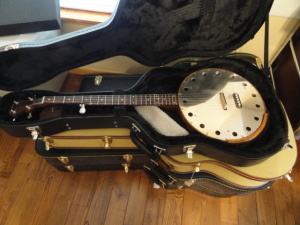
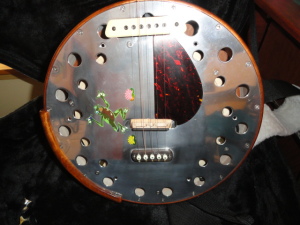
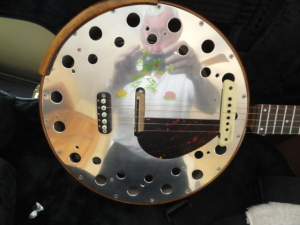
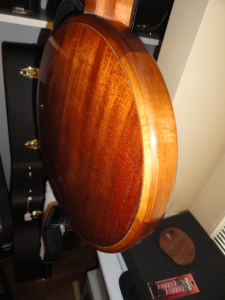
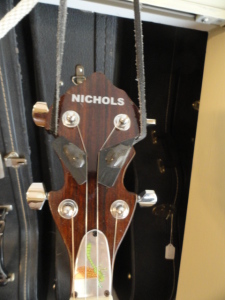
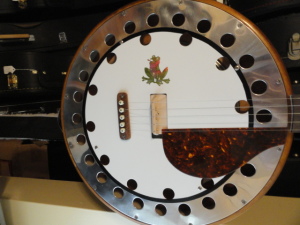
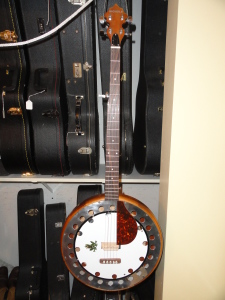
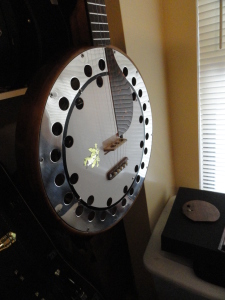
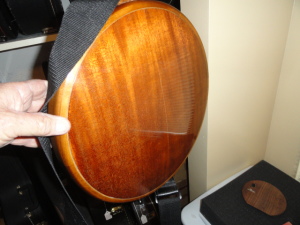
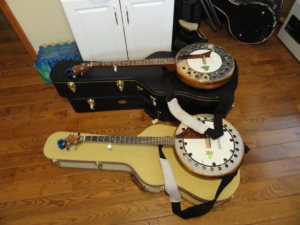
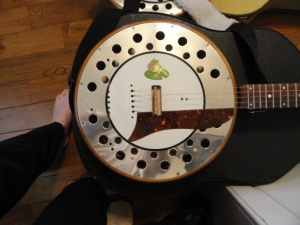
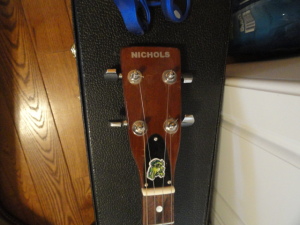
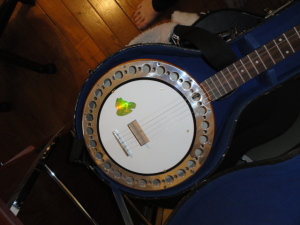
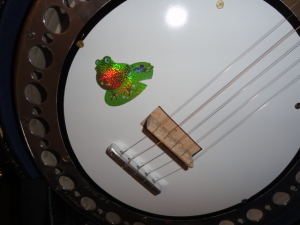
Nice sound. Do you sell them?